Top ten science communication booklets
Bill Dennison ·Maryland's greenhouse gas reduction plan: Executive summary
 This 20 page booklet was produced in 2013 for the Maryland Department of Environment to summarize a long (300+ pp.) and detailed Greenhouse Gas Reduction Plan. The short, bold statements that are highlighted at the beginning of the booklet are very powerful: "Climate change is real. Scientists agree. It's happening now. It's harmful and human caused. We can make a difference through our actions." The various strategies and programs to reduce greenhouse gases were negotiated throughout the production of this booklet, and the reduction numbers for carbon dioxide equivalents were the final edits to the booklet. We made numerous icons for this booklet to depict the different sectors and the cost of inaction. Caroline Wicks and Tracey Saxby collaborated on the design and layout of this booklet, which involved some stringent deadlines.
This 20 page booklet was produced in 2013 for the Maryland Department of Environment to summarize a long (300+ pp.) and detailed Greenhouse Gas Reduction Plan. The short, bold statements that are highlighted at the beginning of the booklet are very powerful: "Climate change is real. Scientists agree. It's happening now. It's harmful and human caused. We can make a difference through our actions." The various strategies and programs to reduce greenhouse gases were negotiated throughout the production of this booklet, and the reduction numbers for carbon dioxide equivalents were the final edits to the booklet. We made numerous icons for this booklet to depict the different sectors and the cost of inaction. Caroline Wicks and Tracey Saxby collaborated on the design and layout of this booklet, which involved some stringent deadlines.
Updating Maryland's sea-level rise projections
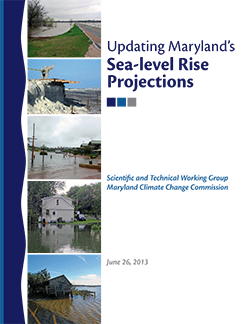 This 22 page booklet was produced in 2013 by a team of 14 scientists led by Don Boesch in order to provide the state of Maryland with the most current sea-rise projections based on best available science. IAN Science Communicators led by Alex Fries produced supporting graphics and designed a very attractive booklet. In addition to the booklet, Maryland Sea Grant produced a supporting 9 minute video about the workshop with images and interviews. Several important findings were highlighted in the booklet, including the effects of sea-level rise on tidal range and storm surge, effects of regional oceanography including the slowing of the Gulf Stream, and effects of land ice melting in Greenland and Antarctica. The overall updated projections of sea-level rise are somewhat sobering, with up to 2.1 feet rise by 2050 and 5.7 feet rise by 2100, which will inundate much of the low lying marshes, farmland and residential areas of Maryland.
This 22 page booklet was produced in 2013 by a team of 14 scientists led by Don Boesch in order to provide the state of Maryland with the most current sea-rise projections based on best available science. IAN Science Communicators led by Alex Fries produced supporting graphics and designed a very attractive booklet. In addition to the booklet, Maryland Sea Grant produced a supporting 9 minute video about the workshop with images and interviews. Several important findings were highlighted in the booklet, including the effects of sea-level rise on tidal range and storm surge, effects of regional oceanography including the slowing of the Gulf Stream, and effects of land ice melting in Greenland and Antarctica. The overall updated projections of sea-level rise are somewhat sobering, with up to 2.1 feet rise by 2050 and 5.7 feet rise by 2100, which will inundate much of the low lying marshes, farmland and residential areas of Maryland.
Responding to major storm impacts: Ecological impacts of Hurricane Sandy on Chesapeake and Delmarva Coastal Bays
 Hurricane Sandy was a devastating storm in 2012 that combined a late season tropical hurricane with an early nor'easter that produced massive storm surges, flooding and power outages in the Mid-Atlantic and Northeast United States. We were asked by the National Fish & Wildlife Foundation to produce a rapid assessment of the ecological damages to the Chesapeake and Delmarva Coastal Bays. We partnered with Maryland Department of Natural Resources and the Maryland Coastal Bays Program to conduct this assessment which included this 20 page booklet. In order to provide context for assessing storm damages, we contrasted the impact of Tropical Storm Lee in 2011 with Hurricane Sandy in 2012. Tropical Storm Lee led to massive freshwater flows down the Susquehanna River, through the Conowingo Dam, and into Chesapeake Bay, but Hurricane Sandy did not produce a major impact to Chesapeake Bay both due to timing (we developed an 'Ecorhythm' graphic to illustrate this point) and the position of the storm track. This booklet was rapidly produced by Brianne Walsh and Tracey Saxby so that it could support the congressional discussion about storm damage appropriations.
Hurricane Sandy was a devastating storm in 2012 that combined a late season tropical hurricane with an early nor'easter that produced massive storm surges, flooding and power outages in the Mid-Atlantic and Northeast United States. We were asked by the National Fish & Wildlife Foundation to produce a rapid assessment of the ecological damages to the Chesapeake and Delmarva Coastal Bays. We partnered with Maryland Department of Natural Resources and the Maryland Coastal Bays Program to conduct this assessment which included this 20 page booklet. In order to provide context for assessing storm damages, we contrasted the impact of Tropical Storm Lee in 2011 with Hurricane Sandy in 2012. Tropical Storm Lee led to massive freshwater flows down the Susquehanna River, through the Conowingo Dam, and into Chesapeake Bay, but Hurricane Sandy did not produce a major impact to Chesapeake Bay both due to timing (we developed an 'Ecorhythm' graphic to illustrate this point) and the position of the storm track. This booklet was rapidly produced by Brianne Walsh and Tracey Saxby so that it could support the congressional discussion about storm damage appropriations.
A decision-maker's guide to using science: A scientist's guide to influencing decision-making
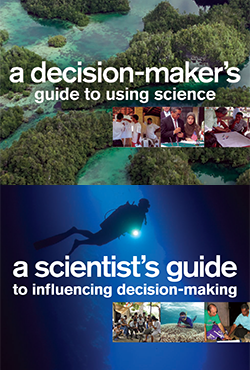 This 20 page booklet was produced following the series of science communication publications that we produced with Conservation International (CI) regarding their Science to Action initiatives. At the end of the series, Leah Karrer from CI wanted to develop a 'Lessons learned' of how decision-makers and scientists could effectively work together. The science communication innovation developed for this booklet was the double-sided booklet with two front covers. One front cover was titled 'a decision-maker's guide to using science' and other other front cover was titled 'a scientist's guide to influencing decision-makers'. In the printed version, the two covers were flipped, so the second half of the booklet was upside down, encouraging the reader to start the second half from the other cover. The two pages in the middle were laid out as a combined landscape-oriented summary of both approaches. Tim Carruthers, Jane Hawkey and Caroline Wicks were instrumental in producing this unique booklet.
This 20 page booklet was produced following the series of science communication publications that we produced with Conservation International (CI) regarding their Science to Action initiatives. At the end of the series, Leah Karrer from CI wanted to develop a 'Lessons learned' of how decision-makers and scientists could effectively work together. The science communication innovation developed for this booklet was the double-sided booklet with two front covers. One front cover was titled 'a decision-maker's guide to using science' and other other front cover was titled 'a scientist's guide to influencing decision-makers'. In the printed version, the two covers were flipped, so the second half of the booklet was upside down, encouraging the reader to start the second half from the other cover. The two pages in the middle were laid out as a combined landscape-oriented summary of both approaches. Tim Carruthers, Jane Hawkey and Caroline Wicks were instrumental in producing this unique booklet.
Taking steps toward marine and coastal ecosystem-based management: An introductory guide
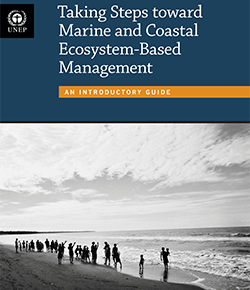 This 68 page booklet was produced for the United Nations Environment Programme in 2011. IAN was asked to develop a series of conceptual diagrams to aid in the explanation of Ecosystem-Based Management.
This 68 page booklet was produced for the United Nations Environment Programme in 2011. IAN was asked to develop a series of conceptual diagrams to aid in the explanation of Ecosystem-Based Management.
The virtual collaboration employed in producing these diagrams was the subject of a previous blog post. These diagrams were an exciting challenge since Ecosystem-Based Management (EBM) an emerging management paradigm that does not have a long history. The diagrams ended up playing a central role in communicating EBM. Tracey Saxby was the Science Communicator and in addition to the conceptual diagrams, we advised the program about the layout and design aspects of the booklet.
Comprehensive strategy for reducing Maryland's vulnerability to climate change, Phase II: Building societal, economic, and ecological resilience
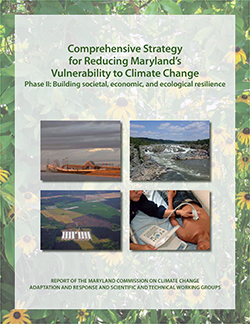 This 68 page booklet follows the previous booklet 'Comprehensive strategy for reducing Maryland's vulnerability to climate change, Phase 1: Sea-level rise and coastal storms'. Both of these booklets focus on adaptation to climate change, not on the climate impacts or steps taken to mitigate climate change through greenhouse gas reductions. However, climate change impacts and the greenhouse gas reduction plan were the subject of other booklets produced by IAN. The climate adaptation effort in Maryland was spearheaded by Zoë Johnson at Maryland Department of Natural Resources and Kate Boicourt led the IAN effort to conduct the workshops, solicit input from various experts and synthesize the results into this booklet. Six groups of scientists were convened to cover the following topics: human health, agriculture, forests & terrestrial ecosystems, bay & aquatic ecosystem, water resources, growth & infrastructure. Sixty authors contributed to this booklet and Kate Bentsen assisted Kate Boicourt with the science communication.
This 68 page booklet follows the previous booklet 'Comprehensive strategy for reducing Maryland's vulnerability to climate change, Phase 1: Sea-level rise and coastal storms'. Both of these booklets focus on adaptation to climate change, not on the climate impacts or steps taken to mitigate climate change through greenhouse gas reductions. However, climate change impacts and the greenhouse gas reduction plan were the subject of other booklets produced by IAN. The climate adaptation effort in Maryland was spearheaded by Zoë Johnson at Maryland Department of Natural Resources and Kate Boicourt led the IAN effort to conduct the workshops, solicit input from various experts and synthesize the results into this booklet. Six groups of scientists were convened to cover the following topics: human health, agriculture, forests & terrestrial ecosystems, bay & aquatic ecosystem, water resources, growth & infrastructure. Sixty authors contributed to this booklet and Kate Bentsen assisted Kate Boicourt with the science communication.
A conceptual basis for monitoring vital signs: Shenandoah National Park
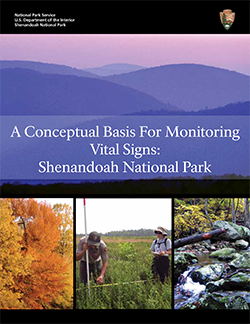 This 20 page booklet was produced with the park service rangers, led by Gordon Olson, at Shenandoah National Park, as a way to provide a broad overview of the ecological monitoring being conducted at Shenandoah National Park. This park has one of the most comprehensive, long term monitoring programs in the National Park system. Shenandoah National Park follows a ridge line just east of the Appalachian mountains in Virginia. This mountain ridge forms the headwaters for the Shenandoah, Rappahannock, York and James Rivers which flow into Chesapeake Bay. This ridge intercepts air masses from the west, relies on rainfall for its water resources and has some unique biota. In order to understand this park, a three dimensional perspective of the mountain ridge is required. Joanna Woerner, the IAN Science Communicator who was the lead on this project, used a digital elevation model and land use map to create various 3-D visualizations. IAN is also following up with a Natural Resource Condition Assessment of Shenandoah National Park, which has benefited greatly by having this initial conceptualization completed.
This 20 page booklet was produced with the park service rangers, led by Gordon Olson, at Shenandoah National Park, as a way to provide a broad overview of the ecological monitoring being conducted at Shenandoah National Park. This park has one of the most comprehensive, long term monitoring programs in the National Park system. Shenandoah National Park follows a ridge line just east of the Appalachian mountains in Virginia. This mountain ridge forms the headwaters for the Shenandoah, Rappahannock, York and James Rivers which flow into Chesapeake Bay. This ridge intercepts air masses from the west, relies on rainfall for its water resources and has some unique biota. In order to understand this park, a three dimensional perspective of the mountain ridge is required. Joanna Woerner, the IAN Science Communicator who was the lead on this project, used a digital elevation model and land use map to create various 3-D visualizations. IAN is also following up with a Natural Resource Condition Assessment of Shenandoah National Park, which has benefited greatly by having this initial conceptualization completed.
People and oceans: Managing marine areas for human well-being
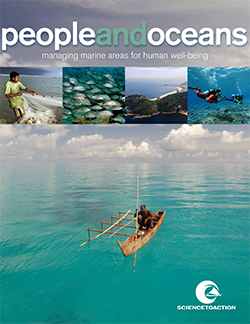 This 20 page booklet was part of a three booklet series produced in partnership with Conservation International to provide scientific support for the use of Marine Protected Areas (MPAs), or Marine Managed Areas. 'People and Oceans' focused on the social and economic reasons for employing MPAs as a way to manage marine resources. The two companion booklets define Marine Managed Areas (MMAs: What, Why and Where?) and provide ecological reasons for employing them (Living with the Sea: Local effort buffer effects of global change). Four regions where Conservation International had been supporting research for Marine Managed Areas were Fiji, Brazil, Belize and Panama. Yet, when it came to convening workshops to scope out these publications, rather than meet in one of these tropical locations, we met in Boston, Massachusetts in the winter. The Fijian and Brazilian scientists were wearing all of the clothes they had or could borrow and were still freezing! In producing these booklets, our IAN team (particularly Caroline Wicks and Tim Carruthers) learned a lot about these exotic locations, even though we did not travel to see them in person.
This 20 page booklet was part of a three booklet series produced in partnership with Conservation International to provide scientific support for the use of Marine Protected Areas (MPAs), or Marine Managed Areas. 'People and Oceans' focused on the social and economic reasons for employing MPAs as a way to manage marine resources. The two companion booklets define Marine Managed Areas (MMAs: What, Why and Where?) and provide ecological reasons for employing them (Living with the Sea: Local effort buffer effects of global change). Four regions where Conservation International had been supporting research for Marine Managed Areas were Fiji, Brazil, Belize and Panama. Yet, when it came to convening workshops to scope out these publications, rather than meet in one of these tropical locations, we met in Boston, Massachusetts in the winter. The Fijian and Brazilian scientists were wearing all of the clothes they had or could borrow and were still freezing! In producing these booklets, our IAN team (particularly Caroline Wicks and Tim Carruthers) learned a lot about these exotic locations, even though we did not travel to see them in person.
Global warming and the Free State: Comprehensive assessment of climate change impacts in Maryland
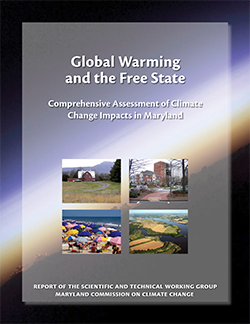 This 92 page booklet assessed the climate impacts in Maryland, and was produced by a team of 22 scientists led by Don Boesch in 2008. Governor Martin O'Malley set up a Climate Change Commission and this was one of the first products produced by the Commission. The booklet had sections on recent and likely climate changes in Maryland, water resources & aquatic environments, farms & forests, coastal vulnerability, Chesapeake Bay & coastal ecosystems, human health, and implications for mitigation and adaptation. Each section had a key points box, and beautiful graphics produced by Jane Thomas and Joanna Woerner. One of my favorite graphics is the map of the East coast of the U.S. with the outline of Chesapeake Bay migrating as far south as Florida by 2100 under the higher emission scenario (p. 19). This graphic vividly displays the implications of climate change on the ecology of Chesapeake Bay. I suspect that this booklet will be viewed in a historical context as a milestone for governmental response to climate change.
This 92 page booklet assessed the climate impacts in Maryland, and was produced by a team of 22 scientists led by Don Boesch in 2008. Governor Martin O'Malley set up a Climate Change Commission and this was one of the first products produced by the Commission. The booklet had sections on recent and likely climate changes in Maryland, water resources & aquatic environments, farms & forests, coastal vulnerability, Chesapeake Bay & coastal ecosystems, human health, and implications for mitigation and adaptation. Each section had a key points box, and beautiful graphics produced by Jane Thomas and Joanna Woerner. One of my favorite graphics is the map of the East coast of the U.S. with the outline of Chesapeake Bay migrating as far south as Florida by 2100 under the higher emission scenario (p. 19). This graphic vividly displays the implications of climate change on the ecology of Chesapeake Bay. I suspect that this booklet will be viewed in a historical context as a milestone for governmental response to climate change.
The role of the coastal ocean in the disturbed and undisturbed nutrient and carbon cycles
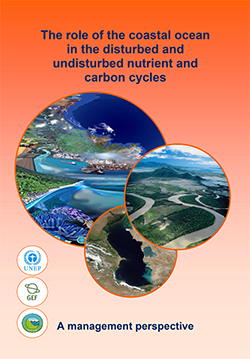 This was one of the first booklets that IAN was called in to help produce. The 44 page booklet was a Land-Ocean Interactions in the Coastal Zone product, produced for the Global Environment Facility, United Nations Environment Programme. Martin de Tissier and Hester Whyte from LOICZ led the synthesis effort. Hester traveled from the LOICZ International Program Office on the island of Texel, Holland to Cambridge, Maryland for our annual IAN Science Communication course - where she did the design and layout of the booklet, with advice from Jane Thomas. A 2006 workshop in Brisbane, Australia was used to assemble the content, but most of the content was assembled after the workshop - we learned from this experience that the workshops should be used to develop the initial draft document, rather than chase down material after the event. I enjoyed my six years on the LOICZ Steering Committee, especially working with the various co-authors of this booklet.
This was one of the first booklets that IAN was called in to help produce. The 44 page booklet was a Land-Ocean Interactions in the Coastal Zone product, produced for the Global Environment Facility, United Nations Environment Programme. Martin de Tissier and Hester Whyte from LOICZ led the synthesis effort. Hester traveled from the LOICZ International Program Office on the island of Texel, Holland to Cambridge, Maryland for our annual IAN Science Communication course - where she did the design and layout of the booklet, with advice from Jane Thomas. A 2006 workshop in Brisbane, Australia was used to assemble the content, but most of the content was assembled after the workshop - we learned from this experience that the workshops should be used to develop the initial draft document, rather than chase down material after the event. I enjoyed my six years on the LOICZ Steering Committee, especially working with the various co-authors of this booklet.
These booklets vary in length from 10-92 pages, and if all ten booklets were combined, it would be the equivalent length of a book (372 pp.). They are quite different in terms of style and content, but all booklets contain maps, conceptual diagrams, photographs, tables and figures in addition to text. In addition, they all have relevant photographs on the front cover and are all multi-author productions. These topical booklets are much quicker to produce than full books and much easier to reproduce and distribute than books, and have become a preferred option for IAN Press publications.
About the author
Bill Dennison

Dr. Bill Dennison is a Professor of Marine Science and Vice President for Science Application at the University of Maryland Center for Environmental Science.
Next Post > Talking about report cards at the National Conference on Ecosystem Restoration
Comments
-
SPLINE CREATIVES LTD- 3DS MAX TRAINING COURSE LONDON 12 years ago
Great Collections of science communication booklets! Bookmarked :)

